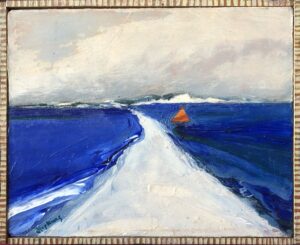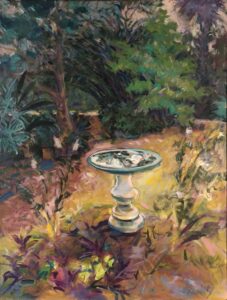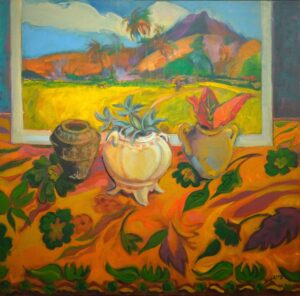Joan Hopkins Coughlin’s Wellfleet home is perched on a hill overlooking Duck Creek, a subject she’s continually returned to in her paintings. By the door in her kitchen hangs a painting of this view. In her composition, land and water weave together, stretching toward the horizon. The painting is dominated by a summertime palette of blues and greens. The loose gestural marks — vivid and unpretentious — are representative of Coughlin’s style.
She’s known locally for capturing such scenes around Wellfleet Harbor and has shown her work (alongside that of her husband, Jack Coughlin) at the Golden Cod Gallery, just down the hill from the house they’ve owned since 1964.

But a more distant land has also captured Coughlin’s imagination throughout her career. Other pictures — more tropical in color and imagery — speak to her upbringing in Jamaica.
In her living room, above a couch covered in crocheted pillows, hangs a painting of two women in a garden bursting with bold colors. “The tall woman is my mother,” says Coughlin. Behind her, in silhouette, a friend sits on the edge of a fountain.
Coughlin painted the image from memory, conjuring the Jamaican garden of her youth. Orange flowers and a yucca plant frame the bottom of the picture, rising upward in rhythmic motion. The grass is rendered in strokes of electric yellow and acidic green. Blue hills undulate in the distance. “I love Caribbean colors,” says Coughlin. It’s a charged environment, full of energy.
Coughlin’s grandfather, Richard Hopkins, grew up in Wellfleet and moved to Jamaica in the 19th century to work for his brother-in-law Lorenzo Dow Baker. Baker famously pioneered the importing of bananas from Jamaica, eventually founding the Boston Fruit Company, which became United Fruit about a decade before his death in 1908.

Coughlin’s father, John Hopkins, grew up in Jamaica but left the island to study mechanical engineering in Boston before returning when his father and younger brother died. Coughlin was born in Kingston, Jamaica in 1936.
“My father kept everything running,” says Coughlin, who describes the environment she grew up in as bucolic and dominated by agriculture. “It was farm life,” she says.
A pair of small paintings on Coughlin’s porch flesh out memories of life in Jamaica. Sitting among a collection of shells and ceramic ducks, the paintings are small but dense with interlocking forms of water and sky in the distance and overlapping figures walking in all directions. The warm, tonal colors in these paintings convey the heat of a Jamaican afternoon and recall the work of Paul Gauguin, one of Coughlin’s favorite artists.
In Still Life With Gauguin, Coughlin creates a scene of pots on a patterned cloth in front of a Gauguin print. “It’s unusual to do a painting of another painting,” says her husband admiringly. Like her depictions of Jamaica, Gauguin’s painting of a Tahitian landscape is teeming with saturated color.

“In a still life, what you’ve chosen should mean something to you,” says Coughlin. “The way you paint it should have something tangible about it.”
Two other still lifes in her home — both of the same vase with flower arrangements — recall memories of her grandmother Ethel Hopkins. “When I was a child, sometimes my family would come back to visit Wellfleet in the summers,” says Coughlin. “My grandmother lived here as a widow.”
Her grandmother acquired the vase on a trip with her husband to visit his brother, Dr. Nathaniel Hopkins, who was doing medical work with Methodist missions in China. Richard died in Hawaii en route to China, but her grandmother carried on and returned with the vase, which now belongs to Coughlin.
Coughlin made her own journey back to the United States after graduating from high school in Jamaica. She attended the Rhode Island School of Design, where she studied illustration and met Jack. Until a few years ago, they split their time between Montague in Western Massachusetts and Wellfleet.
Coughlin continues to paint, although she says it’s hard to finish things these days. “So many of my paintings are unfinished. I don’t know if it’s penance.”
One in-progress painting features a weather-beaten tree near Mayo Beach. Another painting that she completed in the past year is a small jewel-like watercolor from a more recent memory of her life in Montague. It’s a square (one of her favorite formats) and has the same fluid brushwork of her oil paintings. “This is of a little house at the end of a hayfield I used to drive by a lot,” says Coughlin.
Memory and history are the bedrock of Coughlin’s work, whether in the painting of her parents’ garden in Florida, where they lived after leaving Jamaica in the 1950s, or in her images of Bound Brook Island, where her ancestors lived when it was a bustling community. “Bound Brook fascinates me,” says Coughlin. “I think it’s the story: those houses out there. Certain landscapes get you thinking.”
Coughlin is motivated by a fascination with the stories and memories that animate places. Memory is her greatest tool, more useful than the concrete information available working from life. “I find it easier to paint from memory,” she says.
